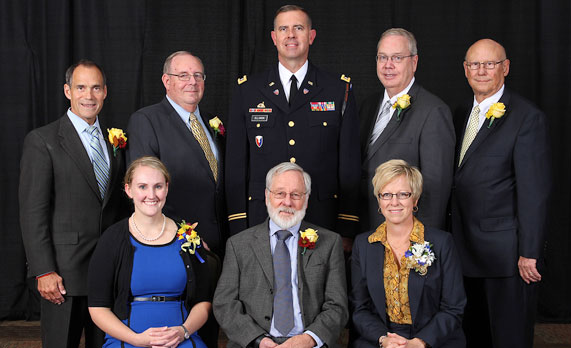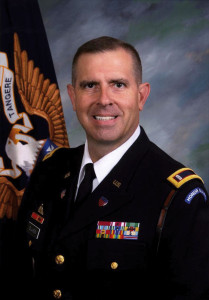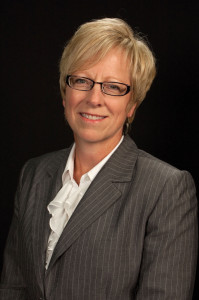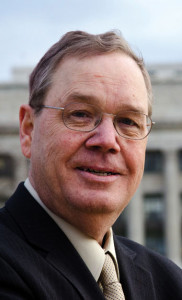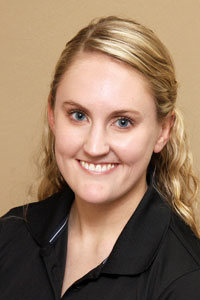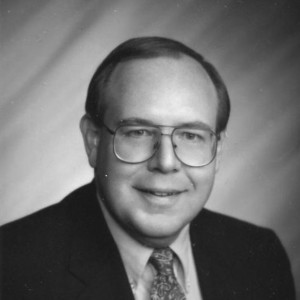This year’s SDSU Distinguished Alumni have worked to make outer space safe for astronauts, led celebrations on Mount Everest and written policies that improve day cares and ensure that citizens in rural America get the loans they need. They have a wealth of experience and we thought we’d tap that expertise by asking each of them a question.
Larry Bell
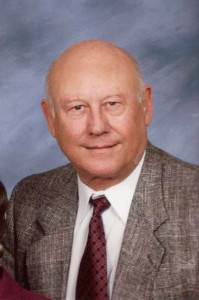 Class of 1958, Friendswood, Texas
Class of 1958, Friendswood, Texas
Professional Achievement
Bell’s career proved that a farmer’s son from Doland could reach for the stars and make a lasting impact on the nation’s space program.
Among the first employees to report for work at the Johnson Space Center in Houston in 1962, Bell led the NASA team that created the life support system and space suit that were used by astronaut Edward White when he stepped out of the Gemini capsule in June 1965 on the first American spacewalk.
SDSU wants to know—
What’s the future of space exploration?
The National Aeronautics and Space Administration is promoting commercialization of space. NASA, in a partnership with several commercial companies, is developing launch systems and spacecraft. This effort is for support to low orbit and the International Space Station.
NASA is developing systems for future exploration of deep space. In addition to the manned programs, there is a balanced investment in unmanned exploration of outer space including other planets and asteroids in our solar systems. Exploration by unmanned spacecraft of future manned destinations is the established method of program planning.
Dr. Richard Deming
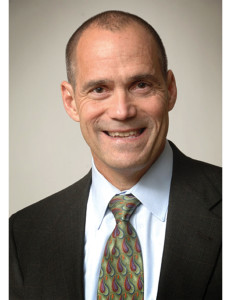 Class of 1976, Des Moines, Iowa
Class of 1976, Des Moines, Iowa
Professional Achievement
Deming earned degrees in chemistry and microbiology at State before attending medical school. He currently serves as the medical director for the Mercy Cancer Center and is founder and chairman of Above + Beyond Cancer, both in Des Moines, Iowa.
Above + Beyond Cancer is a nonprofit organization that provides cancer survivors with unique adventures that challenge them physically while simultaneously broadening their understanding of global cultures and fostering their personal growth. Deming has led cancer survivors on journeys to Mount Everest base camp, the summit of Mount Kilimanjaro and on a 3,000-mile bicycle race in six days, 21 hours and 17 minutes from California to Maryland.
SDSU wants to know—
What’s the source of your seemingly limitless compassion?
As a cancer doctor, I have learned so much about life by witnessing the transformation that occurs when individuals and families face a cancer diagnosis. Cancer becomes a mountain to climb, but it also becomes
a teacher.
Most cancer survivors come through their cancer journey with a new perspective on life. They gain confidence and experience a deep sense of gratitude for having been given a second chance at life. In the process they also acquire courage and a desire to live life fully with passion and purpose.
In addition to the physical challenge of climbing a mountain, I also wanted the Above + Beyond Cancer journeys to explore the spiritual dimension of cancer survivorship. I was interested in exploring how different religions and philosophies interpreted the role of suffering and compassion in the human condition.
As each of us experiences suffering in life, we learn what it feels like to suffer and consequently, we become sensitive to the needs of others who are suffering. It is the experience of our own suffering that encourages us to reach out compassionately to others who are suffering.
These journeys have enriched our lives and cultivated in us a deeper sense of compassion. Now, more than ever, we choose to live our lives fully engaged and passionately committed. No matter how many days we have left on this earth, we have today. It’s only by reaching for something that’s above and beyond what we think is possible that we have any idea what we can really accomplish.
Chief Warrant Officer 4 Fred Ellwein
Professional Achievement
A former National Guard member, the Sioux Falls native has risen through the ranks of the active Army to a unique position as commander of the U.S. Army Old Guard Fife and
Drum Corps.
Concurrent with his National Guard career, Ellwein worked in music education as associate director of bands at Rapid City High School, director of bands at Mitchell High School and Rapid City South Middle
School, and director of bands and jazz studies at South Dakota School of Mines and Technology. In 1988, he was a co-founder of the South Dakota All-State Jazz Festival.
SDSU wants to know—
How do you ensure the quality of each performance when the corps has a schedule that averages 500 performances annually?
Ensuring quality control is a daunting multi-layered effort that is constantly engaged by me and all of my senior noncommissioned officers and drum majors. Each leader-led rehearsal is focused on the performing element — from a solo musician to the largest parade formation of 69 musicians — and the unit standards that must be maintained. The rehearsal also addresses the unique attributes of the mission and performance site.
Each performance is critically observed by me or one of my senior leaders.
Immediately after the performance, an after-action review is conducted to highlight performance goal achievement and illustrate issues of concern. The information gained at these reviews translates into guidance for future mission training.
Jill (Prouty) Franken
Professional Achievement
Improving the health of the state’s largest city may seem like a tall order, but it’s one that Franken is well on the way to accomplishing. Franken has been with the Sioux Falls Health Department for 12 years, appointed as director in July 2010 by Mayor Mike Huether.
Under Franken’s leadership the city has seen expansion of health services to the underserved, strengthened family day care programs, improved school-based health services and directed the development of the Sioux Falls Live Well initiative.
SDSU wants to know—
Municipal health departments are rare. How is a city health department better able to react to community health concerns?
Indeed, municipal health departments are rather rare, and when they exist it is most often to serve a large metropolitan city. Added to that are additional features of our health department that make it even more unique, most notably the fact that we as a health department operate a federally qualified health center — Falls Community Health — which is one of our department divisions and a rarity for public health entities.
Local public health influence to optimize the community’s health comes from several areas of focus and are stated in our mission statement. We aim to prevent or control disease, mitigate adverse conditions or threats, and provide needed access to primary health-care services.
Because we are able to focus this mission on Sioux Falls specifically, we are able to effectively further our vision to understand and from that influence the health and well-being of the residents of our community.
We are able to do that through our coalition building, and through those coalitions create strategies tailored for the specific needs of our community. This coalition building allows for community engagement that is more specific, and success that is more tangible.
Lynn Seppala
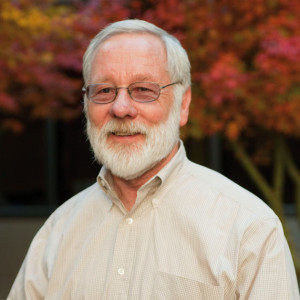 Class of 1968, Livermore, Calif.
Class of 1968, Livermore, Calif.
Professional Achievement
After earning a doctorate in optics at the University of Rochester in New York, Seppala has spent most of his career at the Lawrence Livermore National Laboratory in Livermore, Calif., where his projects have included designs for the first-ever, in-laboratory thermonuclear ignition that could lead to an unlimited source of energy and the Large Synoptic Survey Telescope to be built in Chile.
Seppala’s achievements are all the more impressive due to his personal struggles as he overcame the effects of a stroke at age 46 that paralyzed his right side and seriously affected his speech and cognitive abilities.
SDSU wants to know—
How close are you and your colleagues to creating an energy source with laser-driven fusion?
The National Ignition Facility, at Lawrence Livermore National Laboratory, is the world’s most energetic laser. NIF represents the culmination of 50 years research into laser technology and fusion energy and delivers about 100 times more energy than any other laser, and is well on the way to demonstrating ignition and energy gain.
Our team has been working with utilities, industry and academic partners on the design of a power plant based on the expected performance of the NIF laser. This plant, with appropriate support, could be operational within 10 years of ignition, to mark the start of the fusion power era.
Dallas Tonsager
Professional Achievement
Tonsager’s career in public service has seen him work for three different presidential administrations and become a lifelong advocate for farmers and the rural way of life in America.
Currently serving as undersecretary of rural development for the U.S. Department of Agriculture, Tonsager oversees a staff of 5,500 in offices nationwide administering an annual budget of $37.5 billion in grants and loans for agencies charged with improving rural housing, utilities and business.
SDSU wants to know—
What do you see as the single greatest challenge facing rural America?
We are the single most important part of the American economy, we must invest in ourselves and our neighbors, and we need to have the self-confidence of our parents and grandparents. Finally, we need to express constantly the pride we all feel in where we live and what we do.
Sara (Daugaard) Venhuizen
Outstanding Young Alumni
Since her days as an electrical engineering undergraduate, Venhuizen has been involved in the effort to interest more female students in careers in science, technology, engineering and mathematics.
Volunteers like Venhuizen are credited with helping the College of Engineering increase its percentage of female students as it became one of the fastest growing colleges of engineering in the nation.
SDSU wants to know—
What special qualities do women bring to the engineering profession?
Every person, man or woman, brings their own perspective and unique experience to an engineering problem. The real issue is that not enough people go into engineering, period.
We could almost double the number of engineering graduates in the U.S. if we graduated as many women as men. Also, studies have shown that part of the reason women don’t go into engineering is simply that they don’t understand what engineers do, and we can fix that!
The SDSU College of Engineering is already making a big difference through their engineering camps for girls.
Steve Imming
Non-alumnus Award for Services to South Dakota
The “Voice of the Jackrabbits†for 19 years on WNAX in Yankton, Imming broadcast more than 200 Jackrabbit football games and more than 500 SDSU men’s basketball games.
Noted for his meticulous preparation and ability to “paint a picture†for listeners, Imming earned six South Dakota Associated Press Sportscaster of the Year awards and the Kolpack Media Award from the North
Central Conference.
SDSU wants to know—
What was the single greatest SDSU sporting contest you ever witnessed?
Broadcasting SDSU football and basketball, I was lucky enough to witness many exciting games that included last-second victories, title-earning wins and record-setting performances.
While there were a lot of games to choose from, one football game that sticks out for me is the 2006 win at Cal Poly when the Jacks scored 23 straight fourth-quarter points to beat a top five nationally ranked team on the road. They finished it by scoring a two-point conversion rather than kicking an extra point for overtime.

